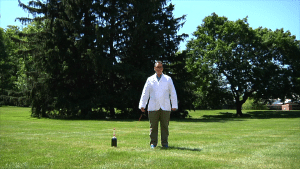Post
Five Gripes About
Children’s Television
22 January 2012
 Grant Gutheil
Grant GutheilLab Coats – Perhaps the most common stereotype about scientists is that they always wear lab coats. This is reinforced in children’s shows, where the “scientist” host wears a lab coat. They wear it everywhere, 24-7. Think Bill Nye, Beakman’s World, Nina and the Neurons, etc. When you see a children’s television host wearing a lab coat, you know they’re a “scientist.” Of course this reinforces the idea that scientists are the “other.” You know scientists couldn’t possibly live in your neighborhood, since you never see anyone mowing their lawn or out for a morning jog in their lab coat.
Science = explosions – Let’s face it, explosions are cool. And nothing gets people’s attention faster than loud noises and fire. (Hey, it works for Mythbusters). Of course in real scientific research, explosions are usually the last thing you want. Real science is about inquiry and observation, not simply blowing stuff up. A variation of this gripe is the common “science = magic” schtick where the lab-coated scientist shows you a trick. Magic? No, Science!
Girls rule, Boys drool – Fortunately there has been a shift away from the idea that only boys do science. There is still a disparity between girls and boys in STEM fields. Although overall more American women than men major in STEM at the college level, women are drawn to areas such as psychology rather than physics or engineering. To address this issue educators have introduced programs such as “Women in Engineering,” which has helped to raise the percentage of girls in those areas. Children’s science television has also shifted to address the interests of girls, and have even developed shows such as SciGirls that focus on women in science. But sometimes in the effort to portray girls in a positive light they also portray boys in a negative light. In SciGirls the effect is subtle. Izzie and the other girls use science to solve problems. The boy Jake, while nice, is a bit clueless about science, and usually needs help from the girls. In other shows, such as Spaced Out: A Cosmic Scene, the effect is more blatant. Here the woman is a smart articulate scientist, while the boyish man is a silent mouth breather whose only role is to be ridiculed.
Actors as “scientists” – Just as the host always wears a lab coat, the host is always a “scientist.” Of course, they aren’t scientists, they’re professional actors (okay, Bill Nye is also an engineer). There isn’t anything wrong with actors playing the role of a scientist on a children’s television show, except when the host is always a “scientist,” and only the “scientist” leads the science. This reinforces the idea that only scientists can do science, when in fact anyone can. Imagine if we taught kids that only professional athletes do sports, while kids can only “play” doing sports (and only under the careful observation of a real athlete).
Answers from authority – When your host is a scientist, you always know that he or she will give you the right answer in the end. The expert will tell children what is right or wrong rather than encouraging children to develop their own answers based on inquiry and observation. Rather than demonstrating observation, inquiry and scientific thinking, many children’s shows simply have the scientist host dictate the answer from on high.